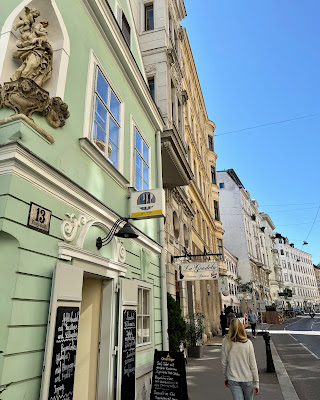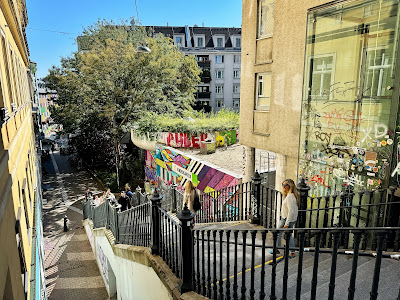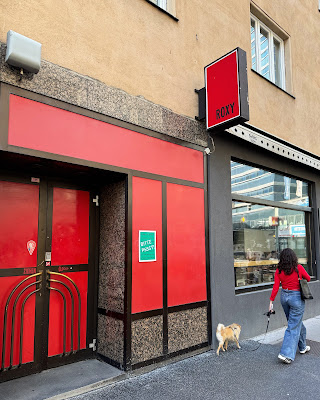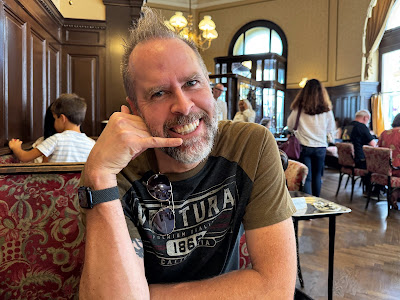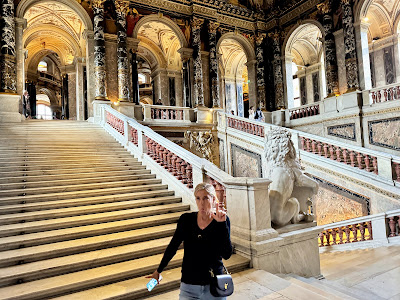I have wanted to visit Vienna ever since I first watched the movie, "Before Sunrise", in 1995 so I was super excited for our trip at the end of September. (The movie stars Ethan Hawke & Julie Delpy and follows their characters, Jesse & Celine, who meet on a train to Vienna and spend the rest of the day and night walking around the city talking and falling in love.) During our flight leg to Istanbul, we lucked out with an empty seat in our row so Tori and I were able to stretch out a bit on the long flight. I think the three young American men in front of us were on a Greek Orthodox pilgrimage to the ancient city since they talked loudly about religion for the entire flight. I might have enjoyed overhearing a theological discussion but all they did was quote unrelated scriptures to each other for 13 hours. It felt like they were preaching at each other, trying to impress instead of holding a real in-depth religious conversation. We had a four hour layover in the huge Istanbul airport, walking around the shops, before catching our short flight to Vienna and riding the airport train into the city center. After 24 hours of travel, we arrived at our hotel, The Leo Grand, at 8pm. We were exhausted after checking in, but we managed a short walk around the majestic St. Stephen's Cathedral next to our hotel before going to bed.
Since we arrived in Vienna during the evening and went to sleep at a normal hour, we suffered little jet lag when we woke the next morning. We found a pretty view of the green dome of St. Peter's Church outside our window. For breakfast, we walked around the block to the nearby Cafe Korb. We started with the classic Viennese Melange coffee, half espresso and half hot milk with foam. Tori ordered the Viennese Breakfast that came with two rolls with butter and apricot jam and a soft boiled egg still in the shell. She enjoyed it so much she ordered it every time we visited this cafe. I wasn't too hungry so I ordered the Ham & Cheese Toast. Afterwards, we walked over to the nearby Apotheke to buy medicine for Tori's headache. I had to look up on the internet to find Thomapryin, the Austrian version of Excedrin. It worked well, but it lacked the outer coating that prevents the bitter pill from instantly dissolving on your tongue as you try to swallow it.
For our first full day, I planned a walkabout of Vienna's Innere Stad to visit museums and see some of the shooting locations of "Before Sunrise". At 10:30am, we took a subway to the Zollamtssteg Bridge. The small footbridge, built in 1900 with green steel arches that crosses over a lower subway bridge and the Wein River, is the first film location that Jesse and Celine visit after leaving the train together in Vienna. We didn't meet two Austrian playwrights on the bridge, but afterwards we did walk over and board the same trolley on the Ring Road that circles the inner historic district of the city. The grand boulevard, lined with historical buildings, replaced the medieval walls that held off the Ottoman Turks during the famous Siege of Vienna.
Riding the trolley to the far side of the Ringstraße, we exited the same Borse stop next to the former Vienna Stock Exchange building. In the park behind, we shared some tasty kimchi from the Alles Wurscht sausage stand. Continuing our walk, we climbed the stairs to Mölker Steig, a narrow winding cobblestone alley from the movie. The two buildings at the end of the alley were also the location of an iconic scene from "The Third Man" where Orson Welles character is revealed inside the darkened doorway. Leaving the small neighborhood, we passed a bride and her wedding party outside the Schottenkirche and the famous Cafe Central with a long line outside. We weaved inward through the crowded Kohlmarkt shopping area to see the front side of St. Peter's Church near our hotel. The ornate domed church is perfectly framed by the buildings on either side and we could see our tiny room window from the street. A few steps away stands the Column of Pest, erected as a memorial by Emperor Leopold I after one of the last great plague epidemics that hit the city in 1679.
Heading towards the Hofburg Palace, the seat of the former Austrian Empire, we decided to visit the Imperial Treasury inside the palace grounds. The museum holds the Imperial Crown of Austria as well as the Imperial Crown of the Holy Roman Empire that the Hapsburgs also ruled for most of its existence. As well as the crown jewels and other royal regalia, the treasury contains royal heirlooms like a narwhal tusk, believed to be an unicorn horn at the time and an agate bowl believed to be the Holy Grail. The museum also holds the cradle for Napoleon's son with Archduchess Marie Louise, the daughter of the Austrian Emperor. After World War II, the US Army returned all the items the Nazis' stole from the treasury.
In another section of the Hofburg Palace is the Austrian National Library. The most impressive part of the former Imperial Court Library is the Prunksaal, or State Hall. The two-story high wooden book shelves are lined with marble columns and statues of Habsburg Emperors under a twenty meter high dome covered with colorful ceiling frescos. While the leather-bound tomes in the cases are just copies of their valuable collection, they do display rare items in the glass cases lining the room. This magnificent hall is the library equivalent of St. Peter's Basilica in the Vatican.
Our next stop was the raised square in front of the Albertina Museum. Jesse and Celine talked along the stone balustrade in a scene from "Before Sunrise" and return later in the movie to sit under the Statue of Archduke Albrecht in the early morning hours before leaving the city. We were starting to get hungry so we stopped at a Würstlstand on the walk back to the hotel for a Kasekrainer and an OttaKringer beer. The cheese-filled sausage served with mustard was delicious! An Austrian from the city of Gatz shared some of his horseradish (kren) with me and I will never order from a sausage stand without it again. He was a nice guy and recommended that we visit the Schweizerhaus for the beer and the roasted pork knuckle.
After a rest break at the hotel, we boarded the subway (U-Bahn) to visit Arena Beisl on the outskirts of the city. The former industrial slaughterhouse is now an alternative music venue and its bar served as a film location where Jesse & Celine played pinball and drank a few beers. Unfortunately, the bar was closed for a music concert so we headed back for dinner at Zwölf Apostelkeller. This underground restaurant sits in an ancient cellar and serves traditional Austrian dishes. Drinking Schnapps, Tori ordered the Veggie Strudel and I had the Kasespatzle, a rich cheesy spätzle pasta topped with crispy fried onions and chives.
After dinner, we walked off our meal through the winding streets of the inner city to the Catholic Church Maria am Gestade. The exterior of the narrow Gothic church was filmed in "Before Sunrise" and "The Third Man" in the 1940s. In the older film, the buildings on the right side of the church are exactly the same but the bombed-out rubble on the left hand side of the stairs has now been replaced by a more modern building. In "Before Sunrise", Jesse & Celine go inside the 2nd oldest church in the city but a different location was used to film the interior scene. Nearby, we walked past the oldest church, Ruprechtskirche, built atop one of the few remaining pieces of the city's fortifications. Lastly, we visited the Ankeruhr, the large mechanical clock built in 1914. Every hour, a new revolving figure moves to the front of the clock with accompanying organ music. For dessert, we bought some cookies at the attached grocery store to take back to our hotel room.
After breakfast at Café Korb on Saturday morning, we took the subway out to the Maria-Theresien-Platz. The square is named after the memorial of Empress Maria Theresa that stands at the center. The only ruling female Austrian Empress, her successful reign lasted from 1740 to 1780. We also checked out the four Tritons & Naiads Fountains that Jesse and Celine wander past in "Before Sunrise". Across the street, we saw kids learning how to use the German Wheel. It is a form of gymnastics invented in Germany in 1925 using a giant metal wheel. In the nearby MuseumsQuartier, we took the elevator to the MQ Libelle rooftop bar for the area views.
Our next stop was the cobblestone alleys of Spittelberg, walking the same narrow streets where Jesse and Celine talked and encountered the belly dancer. I did a little dance myself on the same small square before we walked on to the Alt & Neu Records Store. The listening booth scene at the back was my favorite moment in the movie. The booth is now gone but the rest of the store looks exactly the same.
On our way to the Vienna's famous outdoor market, we passed Otto Wagner’s Majolikahaus, an Art Nouveau building famous for its colorful floral tiles. The busy Naschmarkt across the street was built over the Wien River that runs underground in this part of the city. From 1793 onwards, all fruits and vegetables brought to the city with carts had to be sold there. Now the numerous stalls sell all types of food and spices, with covered restaurants at one end and a flea market on the other. The ROXY Club where Jesse is given a bottle of wine by the bartender is still in the same neighborhood but it was closed when we walked down Schleifmuhlgasse. A few blocks away, we found the Preßgasse house where Jesse and Celine heard the Harpsichord playing through the basement windows at dawn. The windows are still there with their wrought iron grilles.
On Gumpendorfer Straße, we stopped at Café Sperl for lunch. Luckily, we were seated in the same fabric covered booths where Jesse and Celine played the telephone game in "Before Sunrise", another favorite scene of mine. I had the Frankfurter Würstl sausages with horseradish while Tori ordered the popular Viennese dish, Eiernockerl (egg dumplings) with green salad. We didn't realize it at the time, but Eiernockerl was supposedly Hitler's favorite dish.
After lunch, we headed over to Mariahilfer, one of the major shopping streets in the city. When we arrived, Palestinians were marching down the street, protesting the war in the Gaza Strip. Two men were carrying large bell drums that echoed down the long street corridor. Further down, Tori wanted to stop at HEMA, the Dutch department store and Müller, the German drug store. We also checked out the Austrian version of TJ Maxx before entering the Catholic Church Mariahilf on the same street. "Before Sunrise" used this church's interior for a scene that took place at the Maria am Gestade church we visited the night before. At the far end of the shopping street, we went inside the Westbahnhoff train station where Jesse and Celine arrive by train and have a tearful goodbye.
After taking the subway back to our hotel and relaxing for a bit, we walked down to Café Sacher for their famous dessert, the Sachertorte, invented by Franz Sacher, supposedly in 1832 for Prince Metternich in Vienna. The torte consists of a dense chocolate cake with a thin layer of apricot jam and coated in dark chocolate icing. I liked that it wasn't as rich as it sounded. Afterwards, we returned to the Albertina next door for the nighttime views from the raised square before heading back to sleep.
Early Sunday morning, we walked over to Zum Schwarzen Kameel (The Black Camel) for breakfast. Over four centuries old, the restaurant opened in 1618 and instantly became one of the most popular in the city, attracting aristocrats and artists like Ludwig van Beethoven. Besides our Melange Coffee, I ordered the handcut bone-in ham with horseradish while Tori had the Fruit Müesli. I thought I was ordering one of their famous open-face sandwiches, but the dish arrived as a pile of sliced ham with black bread on the side. I thought it might be too much but it was so delicious, I ate it all.
After breakfast, we went for a walk through the quiet streets, hearing the choir singing from the Kirche am Hof as we walked past. It was quite peaceful as we passed through the Judenplatz, the former center of the Vienna Jewish Community in the Middle Ages. The Holocaust Memorial in the square remembers the Austrian Jews that died during World War II.
For the first half of the day, we decided to take the subway and visit the Belvedere museum, two baroque palaces built outside the city walls in the early 1700s by Prince Eugene of Savoy. Born in France, but denied a commission in the French Army, Prince Eugene joined the Army of the Holy Roman Empire and fought in the battle that ended the Siege of Vienna by the Ottoman Turks. He went on to become one of the greatest military commanders of his era and one of Europe's richest men. We walked the palace gardens around the Upper Belvedere that eventually became the official residence of Archduke Franz Ferdinand, whose assassination triggered World War I. Walking back to our hotel, we stopped at the Soviet War Monument next to the fountain in the Schwarzenbergplatz. The memorial to honor the 17,000 soviet soldiers who died during the Vienna Offensive in World War II was built by the Red Army during their occupation of the city.
In the afternoon, we took a trolley out to the vineyards growing on the city's northern hillsides. Vienna is the only capital with significant wine growing inside its city limits, fitting for the Austrian's own name for the city, "Wien". On sunny weekends, the Heurigers open up their hillside wine huts among the vines. Starting at the road beside the Nussdorf Cemetary, we began our hike up the steep hillside of the Nussberg where the Battle of Vienna began in 1683, ending the Ottoman Turks siege of the city. We passed a wine hut halfway up, but we continued on until we reached Weinbau Windischbauer near the top. Purchasing two glasses of wine, we sat among the vines with awesome views of the Danube River and the city below. Nearly all Vienna winegrowers produce the traditional Gemischter Satz (field blend), in which different grape varieties are grown together in the same vineyard, harvested at the same time and turned into a single wine.
After our wine, we finished the hike to the top of the Nussberg for a view of the Leopoldsberg Church on the higher hill behind. Hiking back down the hill, we walked through Beethoven Park and past the former home of the famous musician before taking the trolley into the city. For dinner, we ate at the Hungarian restaurant, Ilona Stüberl. I have been craving authentic Beef Goulash for awhile now and Tori ordered the Mushroom version. We both enjoyed the Tarhonya egg-noodles that came with it. I wasn't able to watch the 7pm Chargers Game on my iPad, but we did watch a soccer riot on TV between the two rival Vienna football teams. Fans throwing firecrackers invaded the field after the game and Away Fans have been banned from the next four Vienna Derbies. Most of the time in our room, we just watched American Sitcoms dubbed with German voices.
After another breakfast at Cafe Kolb on Monday morning, we headed over to the Prater amusement park to ride the famous Wiener Riesenrad featured in many films. In "Before Sunrise", Jesse and Celine have their first kiss at sunset as they ride the Giant Ferris Wheel. It was built in 1897 to mark the 50th year of Emperor Franz Joseph's accession to the throne. At 212 feet tall and 200 feet wide, it wasn't the tallest of the Giant Ferris Wheels built at the end of the 19th century, but it became the largest when the others were all demolished by 1920. Heavily damaged in World War II, the wheel was rebuilt with only 15 of the original 30 gondolas. Luckily, we had a short line to board and it took about 15 minutes for us to complete one rotation.
Wandering around the park that used to be the Emperors' private hunting grounds, we spotted the towering Prater Turm right away. Watching the tiny people riding high above us in their carousel swing chairs looked so much fun, we had to try it too. I don't normally have a fear of heights, but I definitely felt scared as we rose high off the ground and rotated to the top of the 384 foot tall tower. The views of the city were awesome!!! Returning to the ground, the swings picked up speed and we could really feel the g-forces at 60 km/h. Going on the Prater Turm reminded me of a favorite photo of Tori and I riding a smaller version of the swing carousel at the San Diego County Fair when we first started dating.
At the base of the tower, we found the Schweizerhaus that the Austrian at the Würstlstand told us about on Friday. We went inside the outdoor beer garden for their draft Budweiser Budvar, a popular beer brand from the Czech Republic. We were served in giant glass mugs with their trademark foamy heads, created by multiple pulls from the assembly line taps. I wanted to try their specialty, Roasted Pork Knuckle (Stelze), but I wasn't hungry enough after breakfast to eat it by myself since Tori is a vegetarian. It looked delicious, but we ordered their tasty homemade potato chips (Rohscheiben) instead.
Leaving the Prater, we took the U-Bahn to the Augarten park to check out the World War II Flak Towers built by the Nazis to defend Vienna against the allied bombing campaigns. The large park opened to the public at the same time as the Prater and is in the French Baroque style with elaborate flower gardens and tree-lined avenues. (Two members of an Estonian band kept approaching us to purchase a CD of their music.) Rising 167 feet tall over the trees, we spotted the Flakturm VII L-Turm, a massive concrete L-Tower with circular platforms for 20mm anti-aircraft guns at each corner. Flak Towers were constructed in pairs, a larger G-Tower (Combat Gun Tower) and a smaller L-Tower (Lead Command Tower). The 180 foot G-Tower stood on the other side of the park and had emplacements for eight 128mm guns and thirty-two 20mm guns.
Taking the trolley back to the Innere Stadt, we stopped at Le Burger, an Austrian burger chain for dinner. The burgers really lived up to the recommendations. Tori loved the veggie patty and we both loved the buns. We ended up returning later in the week where Tori ordered the same thing while I tried the Coleslaw Burger. Down the street, we entered St. Stephen's Cathedral while a service was in progress. While most of Germany converted to Lutheran Protestantism during the Reformation, Austria remained Catholic under the Habsburg Emperors. The gothic cathedral is the tallest Church in Austria, founded in 1137 before the 2nd Crusade, it was rebuilt larger twice and completed in 1578. It survived both Sieges of Vienna by the Ottoman Turks and German Occupation in World War II.
Tori and I also climbed the 343 steps of the South Tower to the high room that served as the main observation and command post for the defense of the walled city during the Turkish sieges. Until 1955, watchmen also manned the tower at night and rang the bells if a fire was spotted in the city. The tip of the South Tower stands 446 feet tall and holds thirteen bells. We had a great view of the city, spotting all the places we had previously visited. Below, we could see the cathedral's multi-colored tile roof and the shorter North Tower that stopped construction in 1511 due to the need to reinforce the city's fortifications before the first Turkish siege. The domed cap of the North Tower now holds the 21-ton Pummerin bell.
After visiting the cathedral, we headed over to the Donaukanal, a former arm of the Danube River that runs alongside the inner city. The now regulated canal was featured in "Before Sunrise" when Jesse & Celine meet a poet sitting on the stairs who offers to write them a poem for a donation. We walked along the same path and I sat on the exact same stairs that leads down to the water. Next to the stairs is the Otto Wagner Schützenhaus that Jesse & Celine leaned against as they waited for the poet to finish writing. The Art Nouveau building, designed by Otto Wagner, was originally part of a lock and weir installation on the canal. We had a nice walk down the promenade, passing several open-air bars and restaurants. Before returning back to our hotel for the night, we took an elevator up to the Lamée Rooftop bar for a couple cocktails. It was busy, but we were able to get a table. It had a great view of St. Stephen's Cathedral lit up at night.
Tuesday was our first rainy day in Vienna. We had lucked out with the sunshine since we arrived in the city right after a major rainstorm ended. The clouds were gathering as we walked through the Neuer Markt on our way to breakfast. The historical square is home to the 18th-century Donnerbrunnen. The four figures around the fountain represent Austrian rivers. The most famous building in the square is the Capuchin Church (Kapuzinerkirche). Completed in 1632, this church & monastery is well known for its Imperial Crypt containing Habsburg royalty. The Turkish Eggs at the Joseph Brot Bakery just down the street were delicious. Tori enjoyed the Vegan Mediterranean dish.
The rain started coming down right after we exited the U-Bahn outside the Schönbrunn Palace. Luckily, we escaped the wet during our 10:50am guided tour. The Schönbrunn became the Imperial Summer Residence after Empress Maria Theresa received the former mansion as a wedding gift and built it into its current form in the 18th century. Our first stop after ascending the Blue Staircase was the palace's ceremonial hall, the Great Gallery with its ceiling frescos and high mirrored walls. The gallery and the surrounding State Apartments were used for courtly events, the glittering focus of palace life. Moving into the East Wing, we saw the elaborately decorated private living apartments of Maria Theresa and her husband, Franz Stephan. During the French occupations of Vienna in 1805 and 1809, Napoleon slept in the memorial room that the Empress created for her husband after his death.
The rain had stopped by the time our tour moved outside to the grounds behind the palace. The triumphal arches of the Gloriette sit on the hill overlooking the statue-lined garden of the Great Parterre and the Neptune Fountain. We hiked up to visit the purely decorative building that now contains a café with lovely views of the palace and the city beyond. We then walked down the tree-lined avenues to the one of the Naiad Fountains that sit at the intersections of the ground's diagonal avenues. At the end of each sits the Obelisk Fountain and the Zoo that serve as visual focal points. From the pool, we visited the Roman Ruins, a monument showcasing the Habsburg Dynasty as the successor to the ancient Roman Empire in their centuries-long role as Holy Roman Emperors. The grounds cover more than a square kilometer and opened to the public in 1779, a year before Empress Maria Theresa died.
While the palace was mostly unoccupied after Maria Theresa's death, it once again became the center of Imperial life after the last Emperor of Austria, Franz Joseph, moved into the West Wing at the beginning of his reign in 1848 and lived there until his death in 1916 during World War I. We didn't tour that side of the palace, but we did exit the grounds through the smaller garden under their windows. We were feeling hungry when we arrived back in the city so we stopped at Joseph Brot for an Eggs Florentine Quiche for Tori and another Käsekrainer sausage with sauerkraut and horseradish for me at the Würstelstand.
We relaxed at the hotel for a few hours before heading to our AcroYoga Vienna class at 7pm. Whenever we visit another city, we always like to practice our Acro with the local community. After we checked in and helped lay down the floor mats for the Intermediate Level class, Hannah and Alexis taught the Four Step Washing Machine. While Tori and I already knew the machine, we have always struggled with the hands transition so it was awesome to learn the proper technique. (Rotating the Hands outward around the Thumbs.) With Paul, our last Acro partner, we even attempted and completed the more difficult Three Step variation. After class, we headed over to Kleines Café for some food. The kitchen was already closed, but we enjoyed some drinks at the cash-only bar. It was the last location we visited from "Before Sunrise" where Jesse & Celine sit outside the bar in the small square and a fortune teller reads their palms. Still craving food, we stopped at Aida Café for Apple Strudel (Apfelstrudel) on our way back to the hotel.
For Wednesday, our last full day in Vienna, we returned to Café Kolb for breakfast and then headed over to visit the Kunsthistorisches Museum in the Maria-Theresien-Platz. It is the largest art museum in Austria, built by Emperor Franz Joseph I in 1891 to open up the Habsburgs' giant art collection to the public. Entering the museum, we climbed the Grand Staircase, lavishly decorated with marble, stucco ornamentation, gold-leaf, and murals, and guarded by Canova's sculpture of Theseus and the Centaur. Our first stop was the Bruegel Gallery, the largest collection of works by Pieter Bruegel the Elder. My favorites of the Renaissance painter were the landscapes of The Tower of Babel and The Fight between Carnival and Lent.
The rest of the museum was very impressive, especially the high dome over the café in the Cupola Hall. Below are my favorite pictures. Posing with Jakob Seisenegger's portrait of Emperor Charles V and Tori viewing the Ecce Homo painting by Titian. The was also an awesome portrait of Archduchess Marie Antoinette, the future Queen of France and a mosaic of her brothers, Emperor Joseph II and Grand Duke Pietro Leopoldo by the Italian painter Pompeo Batoni. The Family Busts of Emperor Leopold I really show off the distinctive Habsburg chin.
After the museum, we returned to Mariahilfer Strasse for lunch at Le Burger and more shopping at TJ Maxx and Hema. For the rest of the afternoon, we just walked around the inner city, stopping at different shops, including a Nespresso store since Tori liked the one in our hotel room. She also wanted to make sure to buy some Mozart Balls (Mozartkugel) to bring home for us and our friends. We ended up buying five bags of the dark chocolate balls filled with pistachio, marzipan, and nougat. After salads for dinner, we found the Demel stall in the Stephansplatz and shared some Kaiserschmarren (Emperor's Mess). The dish of shredded pancakes, sprinkled with powdered sugar and topped with a fruit compote, was supposedly the favorite dessert of the last Emperor. We both enjoyed it before returning to our hotel to pack for our morning flight.
For our flight home, we woke up at 4am to take the U-Bahn and the CAT Train to the airport for our 8am flight. We had a much shorter layover in Istanbul before flying home to LAX. I started to feel sick during the flight and I really felt it during the two hour drive home to San Diego. It turned out to be COVID so I am glad that it held off until the end and didn't spoil our vacation. We had a great time in the city of Vienna. Hopefully we can go back again some day!































































